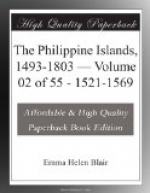[20] This compares favorably with the homestead law of the United States. The institution mentioned in the next sentence apparently was peculiar to Spanish colonial administration in America. Its origin was in the repartimiento, which at first (1497) meant a grant of lands in a conquered country; it was soon extended to include the natives dwelling thereon, who were compelled to till the land for the conqueror’s benefit. In 1503 encomiendas were granted, composed of a certain number of natives, who were compelled to work. The word encomienda is a term belonging to the military orders (from the ranks of which came many officials appointed for the colonies), and corresponds to our word “commandery.” It is defined by Helps (practically using the language of Solorzano, the eminent Spanish jurist), as “a right conceded by royal bounty, to well-deserving persons in the Indies, to receive and enjoy for themselves the tributes of the Indians who should be assigned to them, with a charge of providing for the good of those Indians in spiritual and temporal matters, and of inhabiting and defending the provinces where these encomiendas should be granted to them.” Helps has done good service to historical students in recognizing the great importance, social and economic, of the encomienda system in the Spanish colonies, and its far-reaching results; and in embodying the fruits of his studies thereon in his Spanish Conquest in America (London, 1855-61), to which the reader is referred for full information on this subject; see especially vols. iii, iv.
[21] See the Treaty of Zaragoza, vol. i, p. 222.
[22] This was the dust or residue of the filings from the various assays and operations in the founding of metals, and was usually applied to the benefit of hospitals and houses of charity. It belonged to the king, and was placed under lock and key, one key in possession of the founder and the other of the king’s factor.—Note by editor of Col. doc. ined.
[23] This name is variously spelled Labezaris, Labezares, Labezarii, Lavezarii, and in other ways. This man occupied an important place in Legazpi’s expedition, and was later governor of the Philippine Islands. Several documents by him will appear in this series.
[24] A note by the editor of Doc. ined. says that the religious sent in this expedition were Fray Jeronimo de San Estevan, prior of the Augustinians; Fray Nicolas de Perea, Fray Alonso de Alvarado, and Fray Sebastian de Reina.
[25] A small vessel with lateen sails.
[26] This was the Portuguese governor of Ternate and the Moluccas. The correspondence may be found in the archives of Torre do Tombo.
[27] Apparently a reference to the islands Sarangani and Balut, off the southern point of Mindanao. Regarding Mazaua (Massava, Mazagua) Stanley cites—in First Voyage by Magellan (Hakluyt Society Publications, no. 52), p. 79—a note in Milan edition of Pigafetta’s relation, locating Massaua between Mindanao and Samar. It is doubtless the Limasaua of the present day, off the south point of Leyte.




